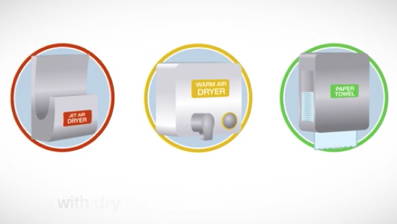 Cleanzine: your weekly cleaning and hygiene industry newsletter 3rd July 2025 Issue no. 1169
Cleanzine: your weekly cleaning and hygiene industry newsletter 3rd July 2025 Issue no. 1169
Your industry news - first
The original and best - for over 20 years!
We strongly recommend viewing Cleanzine full size in your web browser. Click our masthead above to visit our website version.
What might you be taking from the washroom?
 New research by the University of Westminster, commissioned by ETS, the European Tissue Symposium, concludes that drying hands with single-use towels shows a lower level of airborne microbe dispersal and contamination. This could help achieve more hygienic washroom settings.
New research by the University of Westminster, commissioned by ETS, the European Tissue Symposium, concludes that drying hands with single-use towels shows a lower level of airborne microbe dispersal and contamination. This could help achieve more hygienic washroom settings.
The study, undertaken by microbiologist Keith Redway who has already presented top line findings at last year's HIS Conference in Lyon, looked at the potential for microbial contamination from hand-drying and the potential risks for airborne microbe dispersal, particularly if hand washing is sub optimal.
Four different hand drying methods and three different test models were used to determine differences between the drying methods and their capacity to disperse microbes on the hands of users to other occupants of public washrooms and into the washroom environment.
Paper towels, a textile roller towel, a warm air dryer and a jet air dryer were compared using three different test models: acid indicator with lemon juice, yeast, and bacterial transmission from hands when washed without soap. The peer-reviewed study was published in the March 2015 edition of the Journal of Hospital Infection.
A jet air dryer dispersed liquid from users' hands further and over a greater range - up to 1.5m - than other hand drying methods. The jet air dryer also led to the greatest dispersal of microbes into the air at both near and far distances for each of the tested models.
Levels recorded at the drying device revealed an average of 59.5 colonies of yeast for the jet air dryer compared with an average of just 2.2 colonies of yeast for paper towels. At a distance of 0.2 m jet air dryers resulted in 67 colonies compared with only 6.5 for paper towels. At a distance of 1.5 m the jet air dryer recorded 11.5 colonies of yeast compared to zero for paper towels.
"These findings clearly indicate that single-use towels spread the fewest microbes of all hand-drying methods," says Keith Redway. "Cross contamination in public washrooms is a legitimate public health concern. The extent to which jet air dryers disperse microbes into the washroom environment is likely to have implications for policy guidance to facilities managers operating in a wide range of environments from sports stadia and airports through to schools and hospitals."
The study also looked at the body height at which microbes were dispersed. It found the greatest dispersal was at 0.6 - 0.9 m from the floor. This is worrying since it equates to the face height of small children who might be standing near a dryer when a parent is drying his or her hands. Small children might therefore possibly be contaminated with the microbes remaining on the parent's hands after washing them.
Roberto Berardi, Chairman of the European Tissue Symposium, comments: "Correct hand drying is crucial in completing the hand washing process and reducing the risk of microbe transmission.
"This latest research by the University of Westminster builds on previous studies such as last year's research by the University of Leeds, and adds to the existing body of evidence demonstrating that hand drying using single use towels offers an unsurpassed level of hygiene when drying hands after visiting the washroom and is associated with lower numbers of microbes both on the hands and in the washroom environment than with warm air or jet air dryers."
Key findings:
* Due to their air flow, electric hand dryers show a greater potential for the dispersal of microbial contamination on the hands at different heights and to greater distances than towels; the jet air dryer showing the greatest potential.
* The visualisation of the air flow from a jet air dryer helps explain the results of this study. Claimed air speeds for jet air dryers of over 600Kph are likely to increase the risk of transmission of microbes from the hands of users to other occupants of public washrooms and into the washroom environment.
T: + 39 011 8128810
E: [email protected]
Video: www.europeantissue.com
9th April 2015







